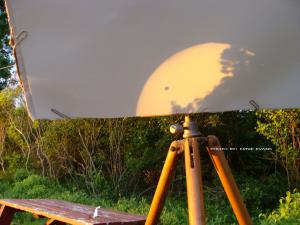The Transit of Mercury
Save the date! On Monday, May 9, 2016 an amazing event is coming to the skies over New England. Mercury, the closest planet to the Sun, will visibly pass in between Earth and the Sun. This is called the transit of Mercury and it will be a sight to see! Of course, Frosty Drew Observatory will be open all day for the transit. All you need to do now is get out and see it!
==========================================
UPDATE: May 11, 2016:
The Transit of Mercury 2016 was a fabulous event with sunny skies for most of the day. Check out our Transit of Mercury 2016 Photos.
==========================================
When an inner planet in relation to Earth's position in the Solar System passes between Earth and Sun we call it Inferior Conjunction, which is generally the closest point to Earth in that planet's orbit around the Sun. Since all planets orbit the Sun slightly inclined to the equator of the Sun (plane of the Solar System), inner planets will usually pass either above or below the Sun from our viewpoint during inferior conjunction. Though sometimes, rather rarely, they pass across the visible area of the Sun. This is what Mercury will do on May 9th.
Mercury, being the closest planet to the Sun, has an orbital period of just under 88 days. So Mercury achieves inferior conjunction about four times per Earth year. Orbiting the Sun at an average distance of 35,983,606 miles with an orbit inclined 7° to the Solar System, the Sun-scorched planet will visibly transit the Sun, on average, twice in a twenty year period.
Unlike the transit of Venus, Mercury will not be so easily visible. To start, NEVER LOOK DIRECTLY AT THE SUN! Get that into your mind, it just may save your sight! Using Eclipse Shades will allow you to safely look at the Sun and will offer views of Mercury as a super tiny black dot slowly moving across the Sun. A telescope setup with a white light filter or hydrogen alpha filter will allow for a much better view of the transit. Please don't look at the Sun through an unfiltered telescope, you will never see again. Though all of those options are great, catching view of the transit at an observatory will be the best option available.
Frosty Drew Observatory as well as Brown University's Ladd Observatory will both be open for the transit. Telescopes will be setup with filters and cameras offering up views of the fabulous celestial event. Mercury will begin crossing the visible area of the Sun just after 7:00 a.m. and will continue across the Sun until about 2:30 p.m., when Mercury will leave the visible solar disk. At Frosty Drew, we will have screens setup on the campus with live views from a telescope fitted with a camera as well as projected views, telescopes, and Eclipse Shades on hand to view the transit.
This is an event certainly not to miss! The next transit will not occur until November 11, 2019 followed by November 7, 2039. So mark your calendars, take that vacation day, call your kids out for a day of science and get your inspiration on. Set out to Frosty Drew or Ladd and catch a fabulous spring-time day with Mercury transiting the Sun. Transit of Mercury at Frosty Drew
- Author:
- Scott MacNeill
- Entry Date:
- Apr 27, 2016
- Published Under:
- Scott MacNeill's Columns




